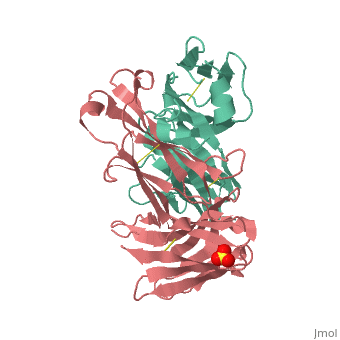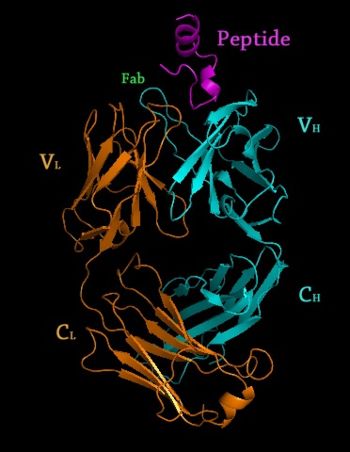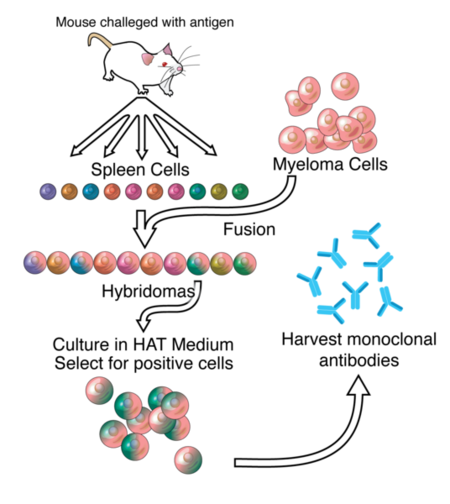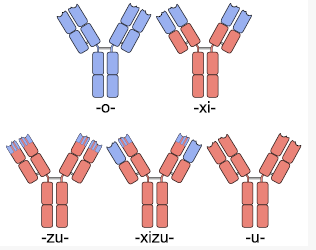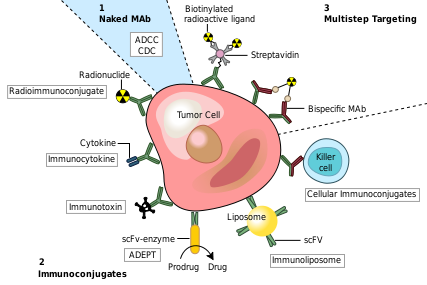Monoclonal Antibody
From Proteopedia
(Difference between revisions)
| Line 2: | Line 2: | ||
[[Image: Rituxan2.jpg|350px|left|thumb| Crystal Structure of Rituximab Fab in complex with an epitope peptide [[2osl]]]] | [[Image: Rituxan2.jpg|350px|left|thumb| Crystal Structure of Rituximab Fab in complex with an epitope peptide [[2osl]]]] | ||
{{Clear}} | {{Clear}} | ||
| + | <scene name='Monoclonal_Antibody/Opening_monoclonal_antibody/2'>Crystal Structure of the Fab Fragment of Matuzumab</scene>, [[3c08]]. Light (blue) and heavy (yellow) chains. | ||
'''Monoclonal antibodies''' are [[immunoglobulins]] produced by a single clone of cells and therefore a single pure homogeneous type of antibody. For structural information on immunoglobulins, see: [[Antibody]] The development of antibodies has revolutionized much of the science world both in the lab and in the medical world in treating cancer and autoimmune disorders. Humanized mouse antibody (hmFab) is a modified mFab which resembles more hFab. Catalytic antibody is a monoclonal antibody with catalytic activity. | '''Monoclonal antibodies''' are [[immunoglobulins]] produced by a single clone of cells and therefore a single pure homogeneous type of antibody. For structural information on immunoglobulins, see: [[Antibody]] The development of antibodies has revolutionized much of the science world both in the lab and in the medical world in treating cancer and autoimmune disorders. Humanized mouse antibody (hmFab) is a modified mFab which resembles more hFab. Catalytic antibody is a monoclonal antibody with catalytic activity. | ||
<br /> | <br /> | ||
| Line 11: | Line 12: | ||
==Original Monoclonal Antibody Technology== | ==Original Monoclonal Antibody Technology== | ||
[[Image: Monoclonal Production.png|450px|left|thumb| Monoclonal Antibody Production via Hybridomas]] | [[Image: Monoclonal Production.png|450px|left|thumb| Monoclonal Antibody Production via Hybridomas]] | ||
| + | {{Clear}} | ||
When an organism is exposed to an antigen, the immune system stages a complex immunological response. One such response is the activation of B-cells and subsequent release of antibodies. To any single antigen, thousands of different B-cells can be activated by their binding different [http://en.wikipedia.org/wiki/Epitope epitopes] on that antigen. When these B-cells subsequently mature into antibody releasing [http://en.wikipedia.org/wiki/Plasma_cells plasma cells], thousands of different antibodies are released into the blood binding and removing the invading antigen. The body creates these “polyclonal” antibodies to guarantee antigens are bound multiple times by antibodies to expedite their removal and serves as a redundant form of immunological security in case some of the antibodies produced are faulty. <ref name="Roit"> Roit, I. M. Roit's Essential Immunology. Oxford: Blackwell Science Ltd., 1997.</ref> In order to be a useful tool in research and medicine however, a single, monoclonal antibody must be isolated. | When an organism is exposed to an antigen, the immune system stages a complex immunological response. One such response is the activation of B-cells and subsequent release of antibodies. To any single antigen, thousands of different B-cells can be activated by their binding different [http://en.wikipedia.org/wiki/Epitope epitopes] on that antigen. When these B-cells subsequently mature into antibody releasing [http://en.wikipedia.org/wiki/Plasma_cells plasma cells], thousands of different antibodies are released into the blood binding and removing the invading antigen. The body creates these “polyclonal” antibodies to guarantee antigens are bound multiple times by antibodies to expedite their removal and serves as a redundant form of immunological security in case some of the antibodies produced are faulty. <ref name="Roit"> Roit, I. M. Roit's Essential Immunology. Oxford: Blackwell Science Ltd., 1997.</ref> In order to be a useful tool in research and medicine however, a single, monoclonal antibody must be isolated. | ||
| Line 22: | Line 24: | ||
===Chimeric Antibodies=== | ===Chimeric Antibodies=== | ||
[[Image: Chimera.PNG |350px|left|thumb| Different Types of Antibodies]] | [[Image: Chimera.PNG |350px|left|thumb| Different Types of Antibodies]] | ||
| + | {{Clear}} | ||
One solution to this problem was the creation of [http://en.wikipedia.org/wiki/Chimeric_antibodies chimeric antibodies]. Chimeric anibodies are antibodies that have the <scene name='Monoclonal_Antibody/Monoclonal_murine/2'>Fab regions of a mouse antibody</scene>, but have <scene name='Monoclonal_Antibody/Monoclonal_human/1'>the Fc region of a human antibody</scene>. These are created by fusing the Fab region coding DNA extracted from mice B-cells as above to human antibody DNA that only codes for the Fc region. Since it is the Fc region of an antibody that is glycosylated and used by the human immune system to determine self vs non-self, and the Fc region in chimeric antibodies is human, these chimeric antibodies typically cause a minimal immune response against them and thus have a longer half life. <ref>PMID:9815926</ref>. Chimeric antibodies typically have a “xi” before the “mab” at the end of their name to indicate their chain type, as is the case with “abciximab” ([http://www.reopro.com ReoPro]), “cutximab” ([http://www.erbitux.com/ Erbitux]), or <scene name='Antibody/Rituxan_starting_scene/1'> Rituximab </scene> ([[Rituxan]]). | One solution to this problem was the creation of [http://en.wikipedia.org/wiki/Chimeric_antibodies chimeric antibodies]. Chimeric anibodies are antibodies that have the <scene name='Monoclonal_Antibody/Monoclonal_murine/2'>Fab regions of a mouse antibody</scene>, but have <scene name='Monoclonal_Antibody/Monoclonal_human/1'>the Fc region of a human antibody</scene>. These are created by fusing the Fab region coding DNA extracted from mice B-cells as above to human antibody DNA that only codes for the Fc region. Since it is the Fc region of an antibody that is glycosylated and used by the human immune system to determine self vs non-self, and the Fc region in chimeric antibodies is human, these chimeric antibodies typically cause a minimal immune response against them and thus have a longer half life. <ref>PMID:9815926</ref>. Chimeric antibodies typically have a “xi” before the “mab” at the end of their name to indicate their chain type, as is the case with “abciximab” ([http://www.reopro.com ReoPro]), “cutximab” ([http://www.erbitux.com/ Erbitux]), or <scene name='Antibody/Rituxan_starting_scene/1'> Rituximab </scene> ([[Rituxan]]). | ||
| Line 38: | Line 41: | ||
Monoclonal antibodies have become a critical tool in most biochemistry labs. They are essential components in [http://en.wikipedia.org/wiki/Immunofluorescence immunofluorescence] experiments as well as in [http://en.wikipedia.org/wiki/Western_blot Western Blot] and immuno [http://en.wikipedia.org/wiki/Dot_blot dot blot] tests to detect protein on a membrane. | Monoclonal antibodies have become a critical tool in most biochemistry labs. They are essential components in [http://en.wikipedia.org/wiki/Immunofluorescence immunofluorescence] experiments as well as in [http://en.wikipedia.org/wiki/Western_blot Western Blot] and immuno [http://en.wikipedia.org/wiki/Dot_blot dot blot] tests to detect protein on a membrane. | ||
[[Image: Applications.png|450px|left|thumb| Monoclonal Antibody Therapeutic Uses]] | [[Image: Applications.png|450px|left|thumb| Monoclonal Antibody Therapeutic Uses]] | ||
| + | {{Clear}} | ||
===Medical Applications=== | ===Medical Applications=== | ||
Monoclonal antibodies have been utilized to create four major classes of drugs. The first activate the bodies own immune system. An example of this is [http://en.wikipedia.org/wiki/Rituximab Rituximab] (Marketed as Rituxan by Roche and Genentech). <scene name='Monoclonal_Antibody/Monoclonal_antibody_binding/1'>Rituximab binds</scene> to CD20 surface proteins on B-Cells and illicits natural immune responses to these cancerous cells via [http://en.wikipedia.org/wiki/Antibody-dependent_cellular_cytotoxicity ADCC], activating cellular [http://en.wikipedia.org/wiki/Apoptosis apoptosis], or by attracting compliment proteins which kill the cell via the [http://en.wikipedia.org/wiki/Complement_system compliment pathway.] <ref>PMID:12200395</ref> Another example of this type of monoclonal antibody drug is [http://en.wikipedia.org/wiki/Infliximab Infliximab] (Marketed as [www.remicade.com/ Remicade] by Merck and the best selling Monoclonal therapeutic in 2008 with over $6 billion in sales). This class of antibodies also includes those antibodies that simply bind a target, disrupting a key mechanism in the diseased cells. | Monoclonal antibodies have been utilized to create four major classes of drugs. The first activate the bodies own immune system. An example of this is [http://en.wikipedia.org/wiki/Rituximab Rituximab] (Marketed as Rituxan by Roche and Genentech). <scene name='Monoclonal_Antibody/Monoclonal_antibody_binding/1'>Rituximab binds</scene> to CD20 surface proteins on B-Cells and illicits natural immune responses to these cancerous cells via [http://en.wikipedia.org/wiki/Antibody-dependent_cellular_cytotoxicity ADCC], activating cellular [http://en.wikipedia.org/wiki/Apoptosis apoptosis], or by attracting compliment proteins which kill the cell via the [http://en.wikipedia.org/wiki/Complement_system compliment pathway.] <ref>PMID:12200395</ref> Another example of this type of monoclonal antibody drug is [http://en.wikipedia.org/wiki/Infliximab Infliximab] (Marketed as [www.remicade.com/ Remicade] by Merck and the best selling Monoclonal therapeutic in 2008 with over $6 billion in sales). This class of antibodies also includes those antibodies that simply bind a target, disrupting a key mechanism in the diseased cells. | ||
Revision as of 08:19, 24 November 2014
| |||||||||||
3D structures of Monoclonal Antibodies
Updated on 24-November-2014
Humanized mouse antibody (hmFab) is a modified mFab which resembles more hFab.
References
- ↑ Roit, I. M. Roit's Essential Immunology. Oxford: Blackwell Science Ltd., 1997.
- ↑ Roit, I. M. Roit's Essential Immunology. Oxford: Blackwell Science Ltd., 1997.
- ↑ Ghosh AK, Spriggs AI, Taylor-Papadimitriou J, Mason DY. Immunocytochemical staining of cells in pleural and peritoneal effusions with a panel of monoclonal antibodies. J Clin Pathol. 1983 Oct;36(10):1154-64. PMID:6194183
- ↑ Klee GG. Human anti-mouse antibodies. Arch Pathol Lab Med. 2000 Jun;124(6):921-3. PMID:10835540
- ↑ Goldstein NI, Prewett M, Zuklys K, Rockwell P, Mendelsohn J. Biological efficacy of a chimeric antibody to the epidermal growth factor receptor in a human tumor xenograft model. Clin Cancer Res. 1995 Nov;1(11):1311-8. PMID:9815926
- ↑ Brady RL, Edwards DJ, Hubbard RE, Jiang JS, Lange G, Roberts SM, Todd RJ, Adair JR, Emtage JS, King DJ, et al.. Crystal structure of a chimeric Fab' fragment of an antibody binding tumour cells. J Mol Biol. 1992 Sep 5;227(1):253-64. PMID:1522589
- ↑ Riechmann L, Clark M, Waldmann H, Winter G. Reshaping human antibodies for therapy. Nature. 1988 Mar 24;332(6162):323-7. PMID:3127726 doi:http://dx.doi.org/10.1038/332323a0
- ↑ Barbas CF 3rd, Kang AS, Lerner RA, Benkovic SJ. Assembly of combinatorial antibody libraries on phage surfaces: the gene III site. Proc Natl Acad Sci U S A. 1991 Sep 15;88(18):7978-82. PMID:1896445
- ↑ Smith GP. Filamentous fusion phage: novel expression vectors that display cloned antigens on the virion surface. Science. 1985 Jun 14;228(4705):1315-7. PMID:4001944
- ↑ Wurm FM. Production of recombinant protein therapeutics in cultivated mammalian cells. Nat Biotechnol. 2004 Nov;22(11):1393-8. PMID:15529164 doi:10.1038/nbt1026
- ↑ Choi BK, Bobrowicz P, Davidson RC, Hamilton SR, Kung DH, Li H, Miele RG, Nett JH, Wildt S, Gerngross TU. Use of combinatorial genetic libraries to humanize N-linked glycosylation in the yeast Pichia pastoris. Proc Natl Acad Sci U S A. 2003 Apr 29;100(9):5022-7. Epub 2003 Apr 17. PMID:12702754 doi:10.1073/pnas.0931263100
- ↑ van der Kolk LE, Baars JW, Prins MH, van Oers MH. Rituximab treatment results in impaired secondary humoral immune responsiveness. Blood. 2002 Sep 15;100(6):2257-9. PMID:12200395
- ↑ Jacene HA, Filice R, Kasecamp W, Wahl RL. Comparison of 90Y-ibritumomab tiuxetan and 131I-tositumomab in clinical practice. J Nucl Med. 2007 Nov;48(11):1767-76. Epub 2007 Oct 17. PMID:17942813 doi:10.2967/jnumed.107.043489
- ↑ Bagshawe KD. Antibody-directed enzyme prodrug therapy (ADEPT) for cancer. Expert Rev Anticancer Ther. 2006 Oct;6(10):1421-31. PMID:17069527 doi:10.1586/14737140.6.10.1421
- ↑ Xu G, McLeod HL. Strategies for enzyme/prodrug cancer therapy. Clin Cancer Res. 2001 Nov;7(11):3314-24. PMID:11705842
- ↑ http://www.nanotech-now.com/news.cgi?story_id=38872
- ↑ Lippow SM, Wittrup KD, Tidor B. Computational design of antibody-affinity improvement beyond in vivo maturation. Nat Biotechnol. 2007 Oct;25(10):1171-6. Epub 2007 Sep 23. PMID:17891135 doi:10.1038/nbt1336
- ↑ Gribenko AV, Patel MM, Liu J, McCallum SA, Wang C, Makhatadze GI. Rational stabilization of enzymes by computational redesign of surface charge-charge interactions. Proc Natl Acad Sci U S A. 2009 Feb 5. PMID:19196981
- ↑ http://f1000scientist.com/article/display/57474/
Proteopedia Page Contributors and Editors (what is this?)
Michal Harel, David Canner, Alexander Berchansky, Joel L. Sussman, Jaime Prilusky
